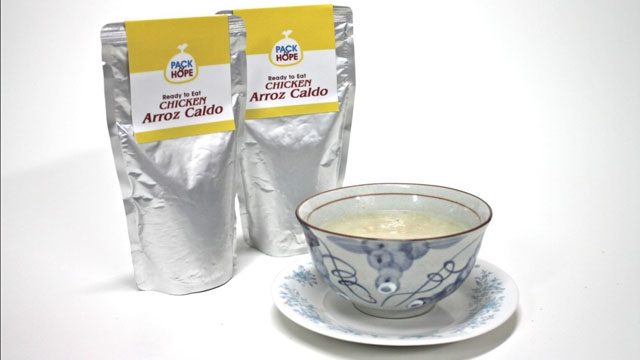SUMMARY
This is AI generated summarization, which may have errors. For context, always refer to the full article.

MANILA, Philippines – The Department of Science and Technology (DOST) recently developed a new type of Ready-to-Eat (RTE) food as solution to hunger problems following disasters that struck several parts of the country in 2013.
After Super Typhoon Yolanda almost 3 million people were put at risk of undernutrition. Some families did not eat for days.
They were forced to make do with what was available, sometimes even resorting to looting, just to survive. (READ: Yolanda survivors after 6 months: homeless, jobless, hungry)
Real-time solution
The Packaging Technology Division (PTD) of the DOST produced RTE chicken arroz caldo meal, dubbed “A Pack of Hope,” to immediately address the hunger problem in areas affected by disasters.
According to PTD head Daisy Tañafranca, the product was designed to withstand the different factors brought about by typhoons or earthquakes. It has a life span of at least one year and can be given to stranded food victims through aerial distribution of about 800 feet.
Three other types of RTEs are currently being processed by the department. These are chicken rice meal, beef tapa rice meal, and corn soup.
RTEs are under the category A of relief goods classification as they do not require preparation and can be eaten without water. Food under this category can sustain a hunger survivor for two days following the disaster.
The rest of the categories are:
- B – Goods that do not require preparation but need to be consumed with drinking water such as biscuits or bread.
- C – Goods that require the addition of hot water such as instant noodles.
- D – Goods that require cooking before eating such as rice.
‘Real’ food
The DOST said that the immediate needs of disaster victims are meals ready to be consumed. Food preparations, including cooking, are elaborate and not advisable in post-disaster situations.
Relief goods in the Philippines are generally emergency food such as canned goods, rice, and noodles. These are usually distributed by local government units together with the Department of Social Welfare and Development (DSWD).
Rice and noodles, considered food staples, require water and heat in cooking which are unavailable after the onslaught of typhoons or even earthquakes due to destroyed infrastructure.
After Yolanda, cooking was nearly impossible due to these missing essentials. Besides, there was no gas and electricity.
In these situations, victims have a hard time gathering the needed supplies to fill their hungry stomachs. This often leads to diseases and malnutrition.
First response
Tañafranca explained that there are 3 stages in distributing relief goods to victims in affected areas.
The first stage involves distribution immediately after a typhoon or earthquake hits and utilities are cut off. The second involves distribution of relief when electricity or water utilities are restored, and the third is when all infrastructure have been cleared, allowing the full restoration of power and water.
While the first two stages are concerned with providing RTEs and instant emergency goods to fill the stomach of survivors, the last stage focuses on the health of the victims by giving nutritious and supplementary food, while at the same combatting the risk of malnutrition and several diseases.
With lessons learned after being hit by natural disasters in the past few years, the DSWD is looking into stocking local facilities with RTEs in the future.
“DSWD now prefers relief foods that are convenient to pack, ready to eat, do not require cooking, with a shelf life of at least one year, and chicken and fish as main ingredients,” Tañafranca said. –Rappler.com
Add a comment
How does this make you feel?
There are no comments yet. Add your comment to start the conversation.